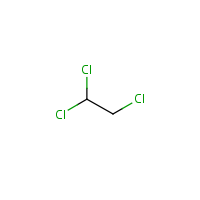1,1,2-Trichloroethane
Agent Name
1,1,2-Trichloroethane
CAS Number
79-00-5
Formula
C2-H3-Cl3
Major Category
Solvents

Synonyms
Ethane trichloride; beta-Trichloroethane; Vinyl trichloride; [NIOSH] 1,1,2-Trichlorethane; 1,2,2-Trichloroethane; Ethane, 1,1,2-trichloro-; Trojchloroetan(1,1,2) [Polish]; Vinyltrichloride; [ChemIDplus] beta-T; Trichloroethane; [CAMEO] UN3082
Category
Chlorinated Aliphatics
Description
Colorless liquid with a sweet, chloroform-like odor; [NIOSH] Clear colorless liquid with a sweet odor; [Matheson Tri-Gas MSDS]
Sources/Uses
Used primarily for synthesis of vinylidene chloride; also used as a solvent in pharmaceutical manufacturing; [ACGIH] Used in lacquers, adhesives, and resins; [HSDB] Used as a solvent for fats, waxes, natural resins, and alkaloids; [Merck Index]
Comments
Acute animal studies: narcosis, anesthesia, and injury to the liver and kidneys; [ACGIH] May cause CNS depression; May cause liver and kidney injury; Can be absorbed through skin; [ICSC] A skin and eye irritant; May cause smarting and reddening of skin if spilled and allowed to remain on clothes; A CNS depressant; Highly toxic by ingestion (liver and kidney damage); [CHRIS] Effects reported in humans include irritation of the conjunctiva, respiratory tract mucosa, and skin, narcotic effects at low concentrations, and fatty degeneration of the kidney and lung injury from chronic exposure; No adverse effects observed in 6-month inhalation studies of rats, guinea pigs, and rabbits; No evidence of developmental toxicity or teratogenicity in mice administered 350 mg/kg/day; [OECD SIDS] An irritant; A CNS depressant; May cause liver and kidney injury; [Matheson Tri-Gas MSDS]
Biomedical References
Exposure Assessment
Skin Designation (ACGIH)
Yes
TLV (ACGIH)
10 ppm
PEL (OSHA)
10 ppm
MAK
10 ppm
IDLH (NIOSH)
100 ppm
Excerpts from Documentation for IDLHs
Basis for original (SCP) IDLH: The chosen IDLH is based on the UCC [1972] report that 500 ppm killed 1 of 6 rats in 4 hours, and 4 of 6 rats in 8 hours. . . . Human data: None relevant for use in determining the revised IDLH.
Vapor Pressure
23 mm Hg
Odor Threshold Low
0.5 ppm
Odor Threshold High
167 ppm
Lethal Concentration
LC50 (rat) = 2,000 ppm/4hr
Explanatory Notes
Odor threshold from "Quick Guide: The Electronic NIOSH Pocket Guide to Chemical Hazards"; Emergency Response Guidebook: "Environmentally hazardous substances, liquid, n.o.s." VP from HSDB;
Reference Link #2
NFPA
must be preheated
Adverse Effects
Neurotoxin
Acute solvent syndrome
Hepatotoxin
Hepatoxic (a) from occupational exposure (secondary effect) or (b) in animal studies or in humans after ingestion
IARC Carcinogen
Not classifiable
ACGIH Carcinogen
Confirmed Animal
Diseases, Processes, and Activities Linked to This Agent
Diseases
Occupational diseases associated with exposure to this agent:
Processes
Industrial Processes with risk of exposure: